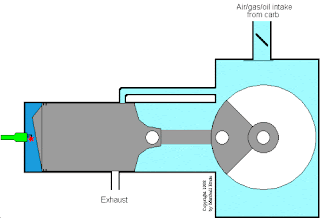Explain how a two stroke engine works?
you can understand a two-stroke engine by watching each part of the cycle in the video below or by looking at these pictures. Start with the point where the spark plug fires. Fuel and air in the cylinder have been compressed and when the spark plug fires the mixture ignites. The resulting explosion drives the piston to the right. Note that as the piston moves to the right, it is compressing the air/fuel mixture in the crankcase. As the piston approaches the bottom of its stroke, the exhaust port is uncovered. The pressure in the cylinder drives most of the exhaust gases out of cylinder, as shown here:
As the piston finally bottoms out, the intake port is uncovered. The piston's movement has pressurized the mixture in the crankcase, so it rushes into the cylinder, displacing the remaining exhaust gases and filling the cylinder with a fresh charge of fuel, as shown here:
Note that in many two-stroke engines the piston is shaped so that the incoming fuel mixture doesn't simply flow right over the top of the piston and out the exhaust port.
Now the momentum in the crankshaft starts driving the piston back toward the spark plug for the compression stroke. As the air/fuel mixture in the piston is compressed, notice that a vacuum is created in the crankcase. This vacuum opens the reed valve and sucks air/fuel/oil in from the carburetor.
Once the piston makes it to the end of the compression stroke, the spark plug fires again to repeat the cycle. It's called a two-stoke engine because there is a compression stroke and then a combustion stroke. In a four-stroke engine there are separate intake, compression, combustion and exhaust strokes.
Explain what is meant, by scavenging when applied to 2 stroke SI engines?
compressed air is sent to the combustion cylinder with the help of blowers etc.,it helps to clean the cylinder of burnt gases, this process is known as scavenging.
Why must roller and ball race bearings be used on 2 stroke SI engine crankshafts?the caged roller bearings are only use in two stroke engines and where invented before the more modern four stroke method of injecting the oil into the sleeve around the bearing to lubricate it. the roller type is where there are a number of linked balls in the bearing they are joined so that they can not all fall to one side of the cage. the evenly spread balls help by spreading the load all around the circumference of the bearing not just in one spot, this prevents uneven wear.
Why are rollers caged in crankshaft bearings?
The roller cylinders are all linked to stop uneven spread of the rollers, they are caged to that the rollers all stay in the right place and so that there is not uneven wear on the bearing
Why must ‘split’ type bearings be used on one piece crankshafts?
Why do we have pins between the piston ring gaps on a 2 stroke?
How does a reed valve work on a two stroke?
How do you check a reed valve?
Explain the term ovality and taper and how are they formed?
How does the piston rings seal in the bore?
What is meant by the terms groove depth, side clearance and end gap on the pistons rings?
Explain the difference between a 2 stroke and a 4 stroke engine?
What is meant by each of the following terms:
(a) Mechanical Efficiency(b) Thermal Efficiency(c) Volumetric Efficiency?
List 2 methods of lubricating the internal parts of 2 stroke S.I. engines?



No comments:
Post a Comment